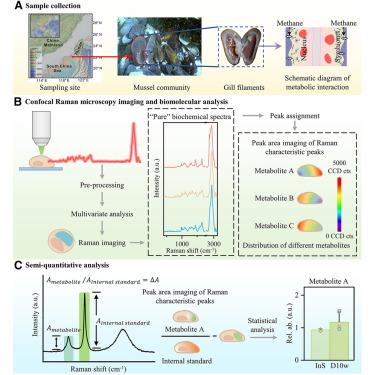In situ semi-quantitative imaging of intracellular metabolic interaction by confocal Raman microscopy
IF 4.1
2区 综合性期刊
Q1 MULTIDISCIPLINARY SCIENCES
引用次数: 0
Abstract
Non-destructive subcellular metabolite quantification can reveal critical insights into biological interactions (e.g., endosymbiont-host crosstalk). Therefore, we developed a multivariate semi-quantitative imaging method using internal standardization to resolve simultaneous subcellular distributions of multiple metabolites, leveraging confocal Raman microscopy’s (CRM’s) high spatial resolution. The method was applied to the endosymbiotic mussel Gigantidas platifrons, whose symbiotic interaction mechanism has not been elucidated because symbionts cannot be cultivated. The results showed that the aggregated distribution of distinct phenotypes of symbiont strains was characterized by different glycogen abundances, indicating niche-driven metabolic strategies. Our data may provide direct evidence suggesting that symbionts supply intermediates to the host for cholesterol synthesis, potentially via vesicular trafficking. This work demonstrates CRM’s capacity for comparative, spatially resolved metabolite quantification across cellular compartments. While semi-quantitative, CRM emerges as a powerful non-invasive tool for probing metabolic network dynamics and compartmentalization in challenging biological systems where traditional methods are limited.

细胞内代谢相互作用的共聚焦拉曼显微镜原位半定量成像
非破坏性亚细胞代谢物定量可以揭示生物相互作用的关键见解(例如,内共生-宿主串扰)。因此,我们开发了一种多变量半定量成像方法,利用共聚焦拉曼显微镜(CRM)的高空间分辨率,利用内部标准化来解决多种代谢物的同时亚细胞分布。该方法应用于内共生贻贝(Gigantidas platifrons),由于共生生物无法培养,其共生相互作用机制尚未阐明。结果表明,不同表型的共生菌株的聚集分布具有不同的糖原丰度特征,表明了生态位驱动的代谢策略。我们的数据可能提供直接证据,表明共生体可能通过囊泡运输为宿主提供胆固醇合成的中间体。这项工作证明了CRM在跨细胞区室的比较、空间分解代谢物量化方面的能力。虽然是半定量的,但CRM作为一种强大的非侵入性工具,可以在传统方法有限的具有挑战性的生物系统中探测代谢网络动力学和分区。
本文章由计算机程序翻译,如有差异,请以英文原文为准。
求助全文
约1分钟内获得全文
求助全文
来源期刊

iScience
Multidisciplinary-Multidisciplinary
CiteScore
7.20
自引率
1.70%
发文量
1972
审稿时长
6 weeks
期刊介绍:
Science has many big remaining questions. To address them, we will need to work collaboratively and across disciplines. The goal of iScience is to help fuel that type of interdisciplinary thinking. iScience is a new open-access journal from Cell Press that provides a platform for original research in the life, physical, and earth sciences. The primary criterion for publication in iScience is a significant contribution to a relevant field combined with robust results and underlying methodology. The advances appearing in iScience include both fundamental and applied investigations across this interdisciplinary range of topic areas. To support transparency in scientific investigation, we are happy to consider replication studies and papers that describe negative results.
We know you want your work to be published quickly and to be widely visible within your community and beyond. With the strong international reputation of Cell Press behind it, publication in iScience will help your work garner the attention and recognition it merits. Like all Cell Press journals, iScience prioritizes rapid publication. Our editorial team pays special attention to high-quality author service and to efficient, clear-cut decisions based on the information available within the manuscript. iScience taps into the expertise across Cell Press journals and selected partners to inform our editorial decisions and help publish your science in a timely and seamless way.
 求助内容:
求助内容: 应助结果提醒方式:
应助结果提醒方式:


